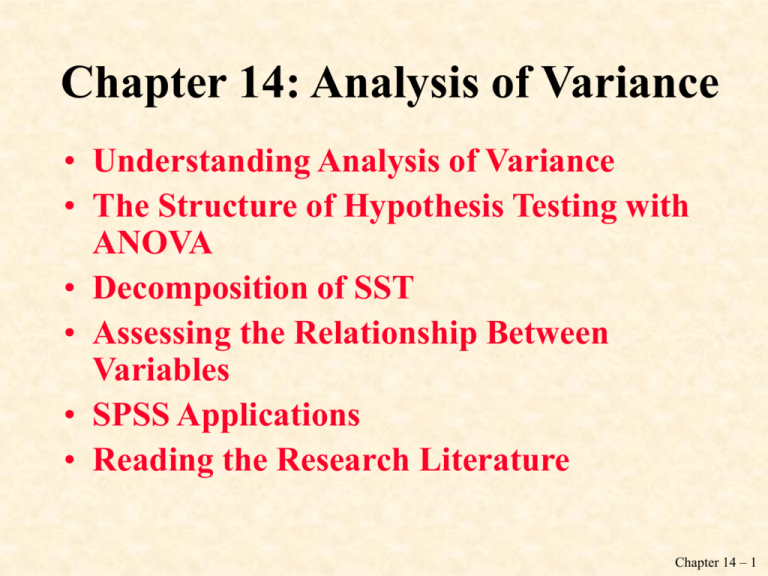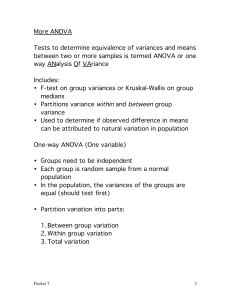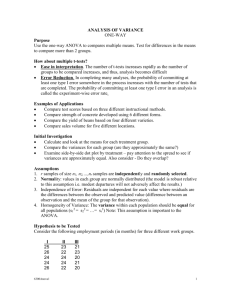Chapter 14
advertisement

Chapter 14: Analysis of Variance • Understanding Analysis of Variance • The Structure of Hypothesis Testing with ANOVA • Decomposition of SST • Assessing the Relationship Between Variables • SPSS Applications • Reading the Research Literature Chapter 14 – 1 ANOVA • Analysis of Variance (ANOVA) - An inferential statistics technique designed to test for significant relationship between two variables in two or more samples. • The logic is the same as in t-tests, just extended to independent variables with two or more samples. Chapter 14 – 2 Understanding Analysis of Variance • One-way ANOVA – An analysis of variance procedure using one dependent and one independent variable. • ANOVAs examine the differences between samples, as well as the differences within a single sample. Chapter 14 – 3 The Structure of Hypothesis Testing with ANOVA Assumptions: • (1) Independent random samples are used. Our choice of sample members from one population has no effect on the choice of members from subsequent populations. • (2) The dependent variable is measured at the interval-ratio level. Some researchers, however, do apply ANOVA to ordinal level measurements. Chapter 14 – 4 The Structure of Hypothesis Testing with ANOVA Assumptions: • (3) The population is normally distributed. Though we generally cannot confirm whether the populations are normal, we must assume that the population is normally distributed in order to continue with the analysis. • (4) The population variances are equal. Chapter 14 – 5 Stating the Research and Null Hypotheses H1: At least one mean is different from the others. H0: μ1 = μ2 = μ3 = μ4 Chapter 14 – 6 The Structure of Hypothesis Testing with ANOVA Between-Group Sum of Squares This tells us the differences between the groups SSB Nk (Y k Y ) 2 Nk = the number of cases in a sample (k represents the number of different samples) Y = the mean of a sample Y k = the overall mean Chapter 14 – 7 The Structure of Hypothesis Testing with ANOVA Within-Group Sum of Squares This tells us the variations within our groups; it also tells us the amount of unexplained variance. 2 i k SSW (Y Y ) Nk = the number of cases in a sample (k represents the number of different samples) Yi = the mean of a sample Y k = each individual score in a sample Chapter 14 – 8 Alternative Formula for Calculating the Within-Group Sum of Squares Y i 2 ( Yk ) 2 nk where n k = the squared scores from each sample, Yi 2 = the sum of the scores of each sample, and Y = the total of each sample k Chapter 14 – 9 The Structure of Hypothesis Testing with ANOVA Total Sum of Squares SST SSB SSW Nk (Yi Y ) 2 Nk = the number of cases in a sample (k represents the number of different samples) Yi = each individual score Y = the overall mean Chapter 14 – 10 The Structure of Hypothesis Testing with ANOVA Mean Square Between An estimate of the between-group variance obtained by dividing the between-group sum of squares by its degrees of freedom. Mean square between = SSB/dfb where dfb = degrees of freedom between dfb = k – 1 k = number of categories Chapter 14 – 11 The Structure of Hypothesis Testing with ANOVA Mean Square Within An estimate of the within-group variance obtained by dividing the within-group sum of squares by its degrees of freedom. Mean square between = SSW/dfw where dfw = degrees of freedom within dfw = N – k N = total number of cases k = number of categories Chapter 14 – 12 The F Statistic The ratio of between-group variance to within-group variance SSB MeanSquareBetween dfb F SSW MeanSquareWithin dfw Chapter 14 – 13 Definitions • F ratio (F statistic) – Used in an analysis of variance, the F statistic represents the ratio of between-group variance to within-group variance • F obtained – The test statistic computed by the ratio for between-group to within-group variance. • F critical – The F score associated with a particular alpha level and degrees of freedom. This F score marks the beginning of the region of rejection for our null hypothesis. Chapter 14 – 14 dfb Alpha Distribution: dfw Chapter 14 – 15 Example: Obtained vs. Critical F Since the obtained F is beyond the critical F value, we reject the Null hypothesis of no difference Chapter 14 – 16 SPSS Example: Bush’s Job Approval Chapter 14 – 17 SPSS Example: Clinton’s Job Approval Chapter 14 – 18 Reading the Research Literature Chapter 14 – 19 Reading the Research Literature Chapter 14 – 20





